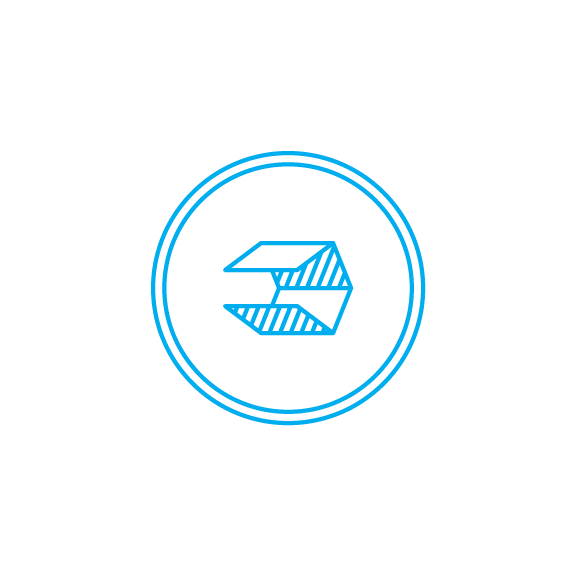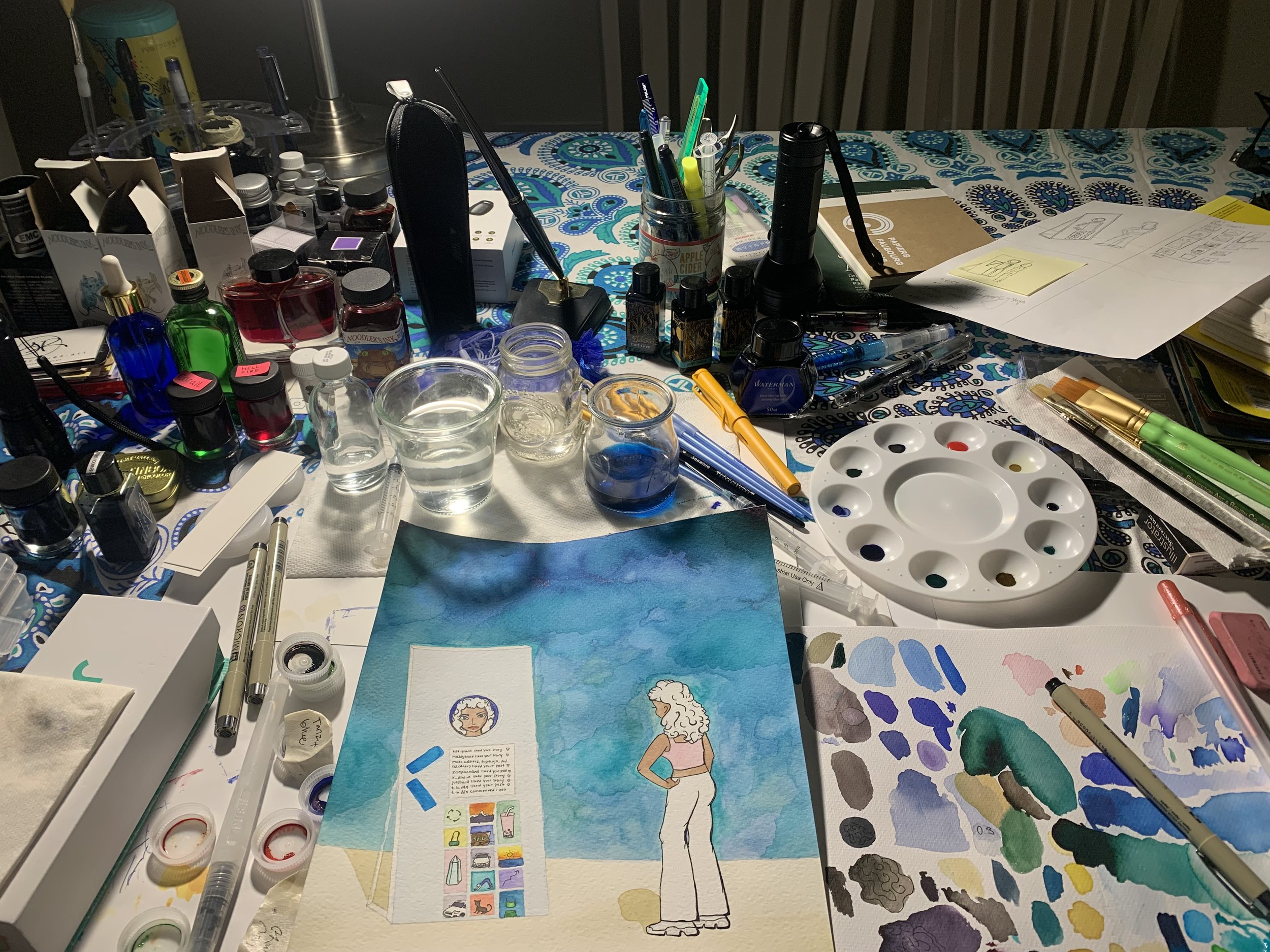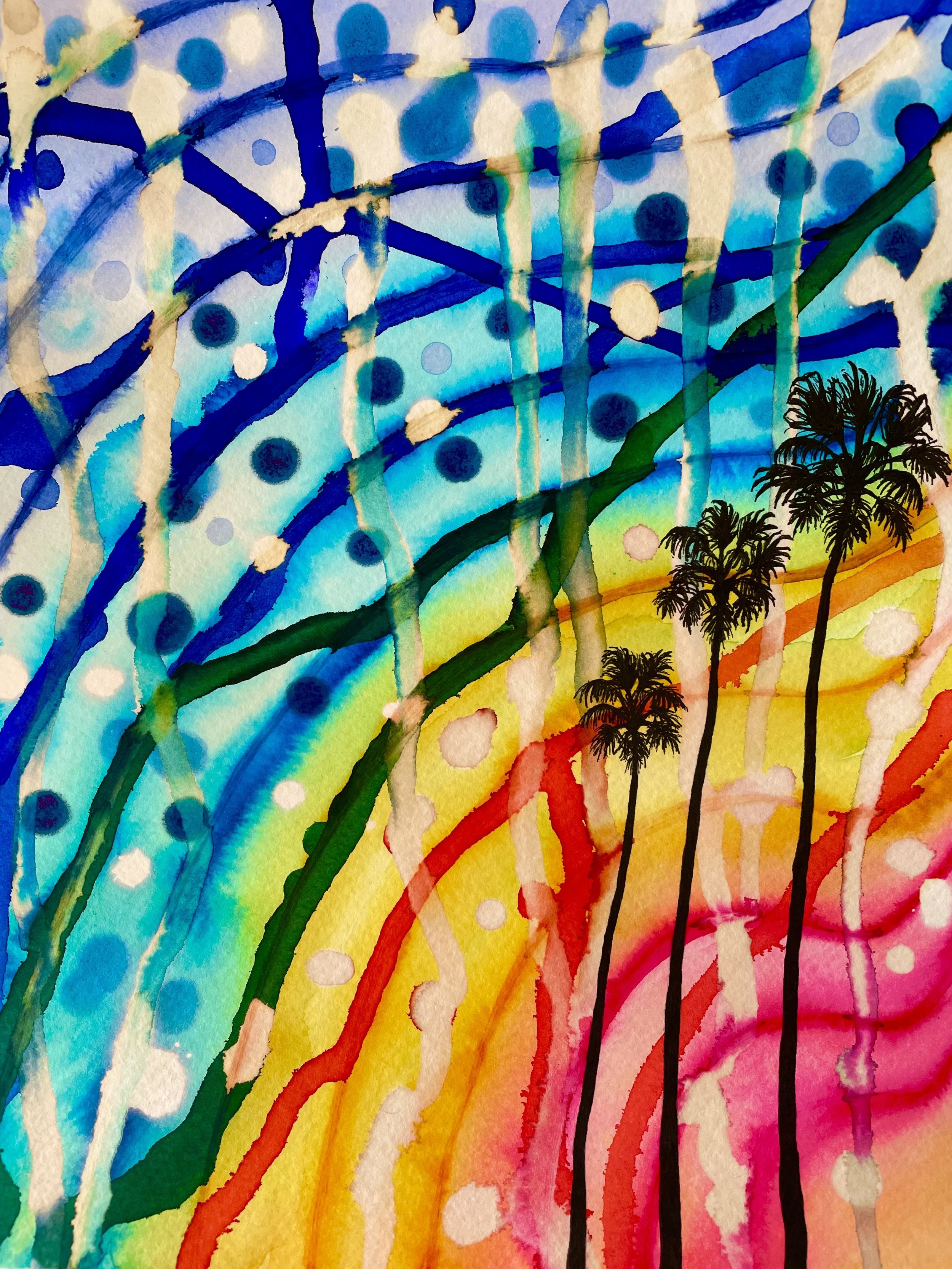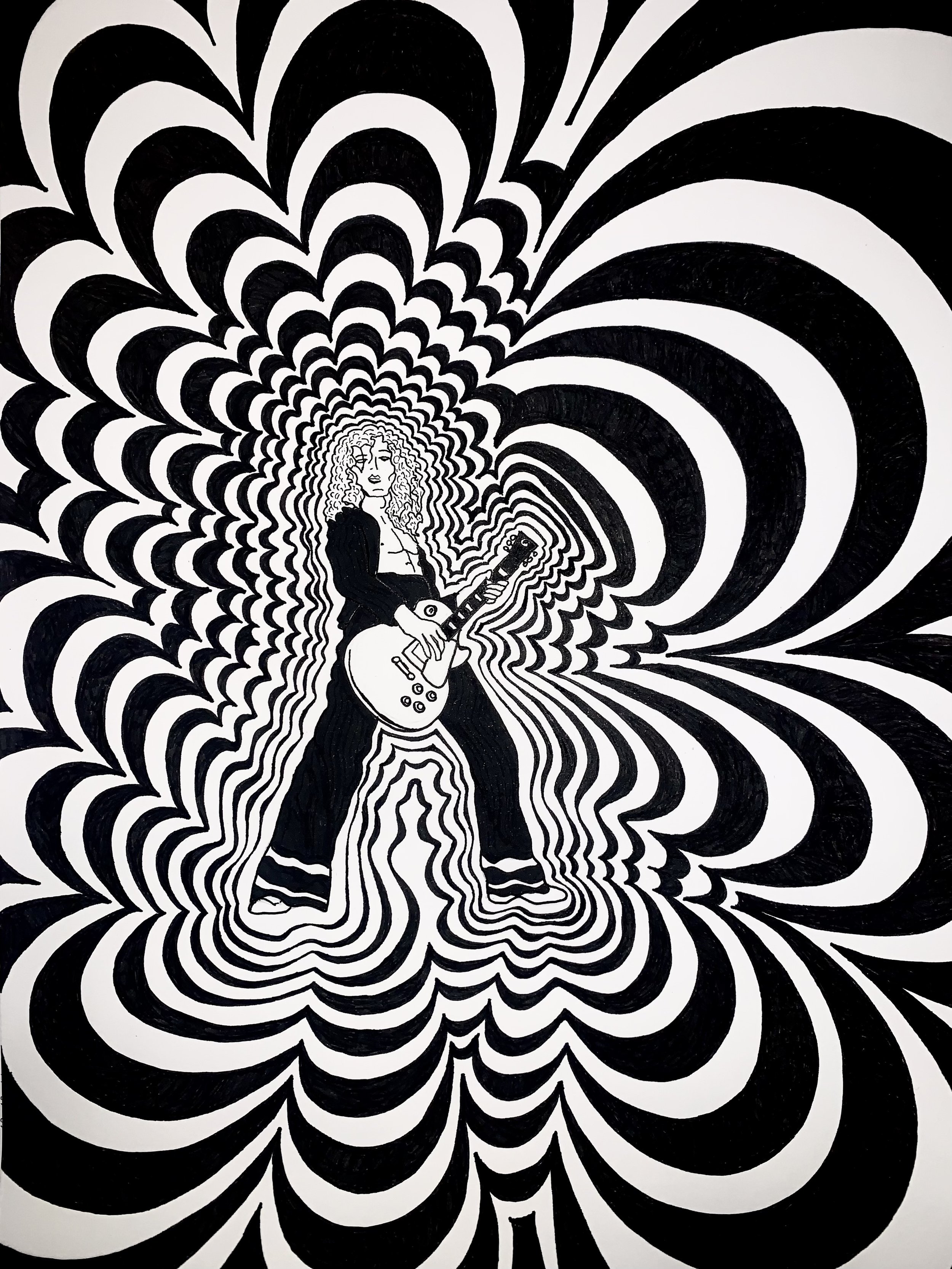Algo Dysmorphia
Arina Martemyanova
Algo Dysmorphia, ink, watercolor and gel pen, 9 x 12 inches
“In some ways, I really am building a community over social media.”
Interview by C. VanWinkle
September 29, 2023
What was the prompt that you responded to? Can you describe it for me?
It was this photograph of a man. He looked pretty upset. He was holding a pear, which he was painting a very unnatural purple color, and there was this hand reaching out to grab it. The piece was called The Algorithm, so that got me thinking that this could be interpreted in two ways. Is the algorithm the man or is it the hand? Is the algorithm trying to get the fruit? Or is the algorithm actually the man making the fruit, and then the hand is the consumer?
What did you decide?
I like that it’s left open-ended so it can be taken both ways. I really focused on the title, The Algorithm, not on pears or hands or whatever. The combination of the title and the photo got me thinking about what the function of the algorithm is and how it affects our self-image and process of creation. I think that was the theme. He was painting something, creating something, and then there's this “algorithm” getting involved. I think the previous person focused on creators getting influenced by the algorithm and how it affects their art. For me, I went more general and thought about how maybe the average person interacts with an algorithm, more of a consumer than a creator.
I see. How did you get started on your own piece?
I gave myself a day just to think it over. I kind of ran through it in my mind, and then an image popped into my head. It just came to me in a flash. Algorithms are used by social media outlets to increase engagement by selecting content that users spend more time interacting with, and then showing them more of the same content, creating a loop. Instagram, for example. Whatever we create or consume on the site bounces right back to us, and the association that I made is that it’s kind of similar to body dysmorphia. People see themselves reflected in the mirror, but it's not really them that they're seeing. It's a distorted version of themselves. And that’s similar to the algorithm on social media. It takes your browser history or whatever, tracks the posts you click on, and then it feeds you back a reflection of that. But that’s not really a true representation of yourself. It’s a distorted version. I think the message is that the way we interact with the algorithm creates a warped perception of ourselves.
That is such an interesting parallel to draw, social media and body dysmorphia. We tend to find a lot of Bait/Switch contributors via social media, so I think a lot of our people can relate strongly to this. What would you say are some of the positive elements of being an artist on social media? What's good about it?
There's this whole question about creating and the algorithm, “Are we really doing this for ourselves? Or for something else?” There's a lot of negativity about that, but in my experience, it's really an overwhelmingly positive place for me. I feel like the art community on Instagram is very supportive and wholesome for the most part. I never see bad comments like, “I hate the colors you used.” It's always the opposite. It's always like, “Wow, I love it!” You know, there are spammy comments about buying your work as NFTs, but that's the worst that it gets. Honestly, everyone else is super nice. I've made a bunch of online friends, but I've made in-person friends too that I've connected with over Instagram. In some ways, I really am building a community over social media. So it's not all bad, you know?
Do you ever feel pressured to change your work or do something differently for social media? Are you still able to do you?
Yeah, I do me. My art is purely a hobby for myself. I haven't made any money on it, so I feel like that really takes away any pressure. I'm considering trying to sell my work, and if things progress, then I might feel some sort of pressure.
For a lot of people, especially if they're trying to pay their rent this way, there's a lot of pressure to do what they think they should, rather than what they want. And that can feel disingenuous. In your case, is your artwork you?
That’s a good question. I actually don’t consider my works “me.” They are my visions, perceptions, and creations, yes, but that is not me any more than my thoughts or feelings. Nonetheless, it’s hard to decouple yourself from these things.
Absolutely. What materials did you use for this one?
The background, the base, is watercolor. Then it's mostly fountain pen ink on top and then micron pens and gel pens. I mostly work with ink. I love to write as well, and then when I got into art, I had like 30 bottles of fountain pen ink and like 30 pens, so I just started using that to paint with. I love it because the colors are so saturated.
I’ve seen some of your other pieces online and I noticed those saturated colors there too. How else does this piece relate to the rest of your work?
I like that this prompt encouraged me to take things in a new direction a bit. I'll be honest, I'm not that good at drawing people. That's a bit of an insecurity of mine as an artist. In some ways, drawing people is expected to be the ultimate skill you can have, to create things like really realistic portraits. I feel like that's such a staple of arts training. Everyone starts with figure drawing and stuff like that. I took some art classes as a child. Then in college I took a course focused specifically on scientific illustration, which is focused on detailed, realistic depictions of plants and animals, but not really people—that would be more like medical illustration.
In most of my work, I combine drawings of natural objects with abstract elements and I love using color to create excitement around the subject. But more recently, I've started trying to depict people as well. A lot of my inspiration has people in it and I want to get better at it. I’ve taken a figure drawing class that I feel has really helped me with this piece, just practicing different poses. That's something I'm excited to be incorporating more into my work: people's interaction with nature.
How do you feel about working from a prompt? Do you do it much?
I haven’t done it much. Just in art class, where they gave you something, and then everyone had to draw from the same prompt. But other than that, I've never done this. I've never taken a commission. I actually really liked it. I was able to think of something pretty quickly. When I first saw the photo, I had no idea what I was going to do with this man holding some fruit; I thought, “I don't know, that's not the type of stuff I draw.” But I came up with something very quickly. Imagination just takes over. On one hand, prompts do set constraints. I couldn't have drawn something completely random. There's a theme you have to think about, but the constraints allow you to channel your creativity.
True, it gives you a starting point. How are you with deadlines? You didn’t seem to have a problem with this one.
No, because I was very excited to work on it. Actually, you gave me two weeks to do this and for the first week I was just busy. I was focused on this other thing that fell through. Then I thought, “Now I have to draw this thing,” and I did it in like 48 hours. [laughs] Honestly, I was working up until the night of the deadline, but it keeps me motivated. I usually create something within a weekend anyway. My medium is pretty quick; ink dries fast. It's not like oil painting, so I can usually knock out a piece within a weekend. This really wasn't too different from my usual workflow.
What advice do you have for a new person just getting started with Bait/Switch?
Trust the process. Trust yourself. It might seem intimidating if you've never done anything like it, you know, like me. But if you're a creative person, you will think of something. You have the skills to do it, so let your intuition guide you. You’ll be fine, and it's a lot of fun.
Call Number: C106VA | C108VA.maAlgo
Arina Martemyanova lives in Florida, managing research projects and the constant flow of her ideas by depicting them on paper. When she’s not painting, she enjoys running and hiking, learning everything she can, and traveling. See more of her work on Instagram at @martem.art.nova.







